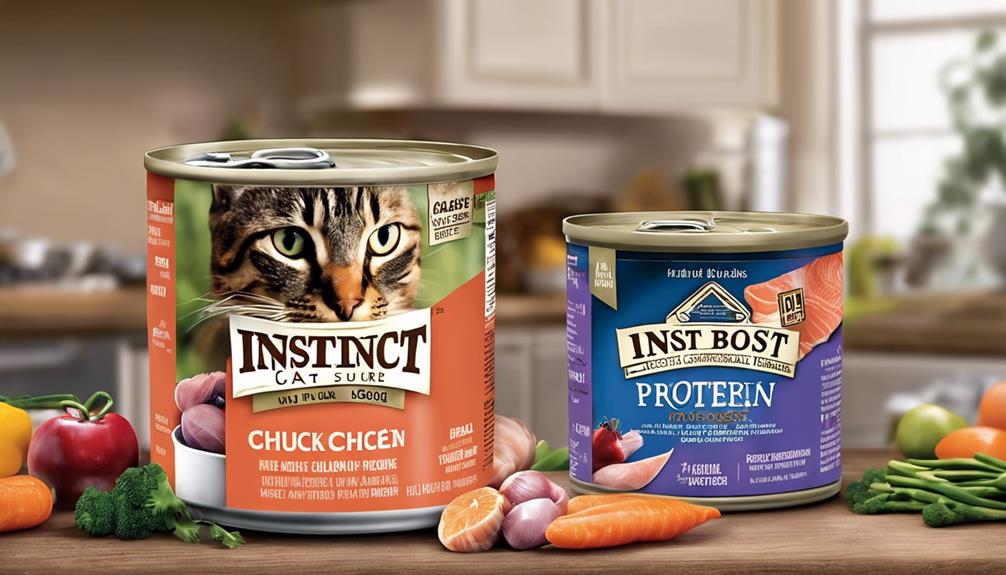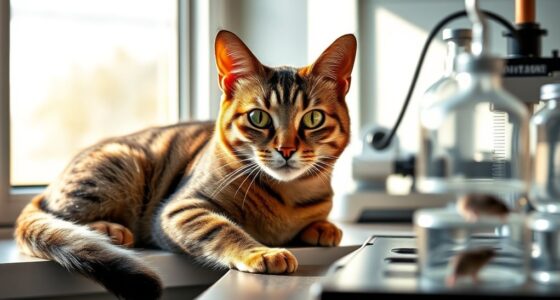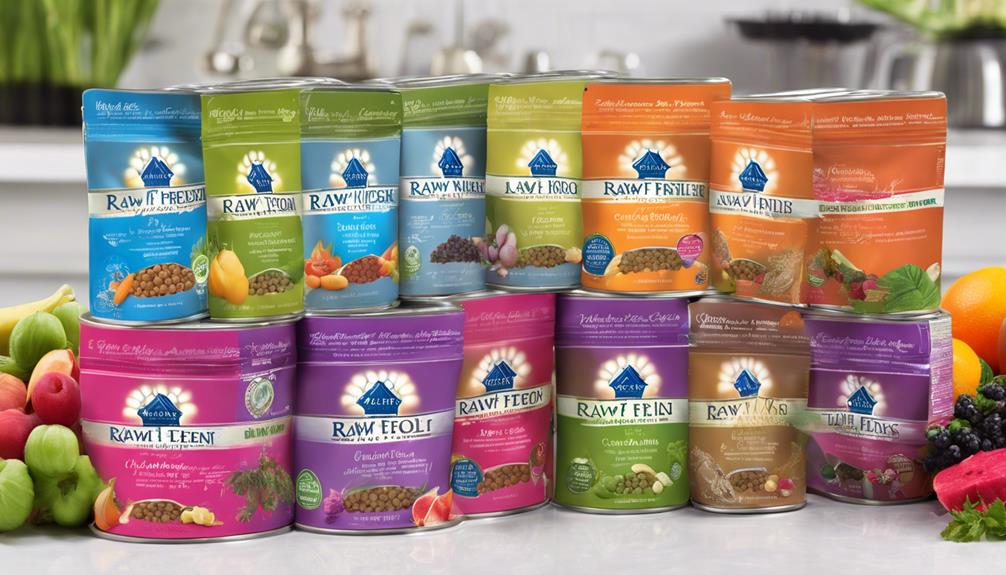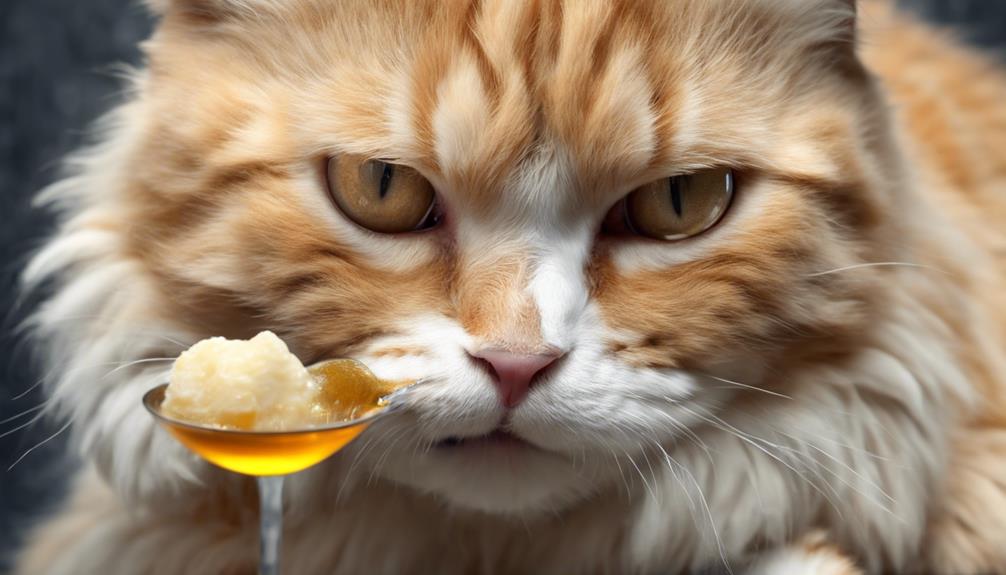Embarking on the journey to provide top-quality raw food for my feline companion involves understanding their nutritional requirements, including animal proteins, fats, taurine, and calcium that are crucial for their carnivorous diet. Seeking advice from vets for personalized recommendations can help avoid health issues and ensure a smooth transition to a balanced raw diet rich in proteins like chicken, rabbit, and organs. Prioritizing safety measures such as proper hygiene and food handling, along with gradual transition tips, feeding guidelines, and recommended raw cat food brands like Instinct Raw Boost and Stella & Chewy’s are essential.
Implementing these measures will assure the prime health and well-being of my furry friend, guiding them towards a healthier and happier lifestyle.
Key Takeaways
- Quality meats like chicken and rabbit for essential proteins and fats.
- Balanced raw diet with organs, bones, and minimal vegetation.
- Veterinarian consultation for tailored recommendations and health monitoring.
- Safety precautions for handling raw meat to prevent contamination.
- Transitioning tips include starting slow, mixing meats, and using probiotics.
Nutritional Requirements for Cats on Raw Diet
When considering the nutritional requirements for cats on a raw diet, prioritizing animal proteins, fats, taurine, and calcium is essential due to their status as obligate carnivores. Cats thrive on a diet rich in raw animal proteins like chicken, rabbit, and organs, which provide essential nutrients important for their heart and muscle health. Feeding cats a balanced raw diet means including flesh, organs, bones, and minimal vegetation to mimic their natural prey. This approach guarantees that they receive the necessary nutrients for best well-being.
Raw feeding for cats can be a rewarding experience, offering a closer connection to their primal instincts and nutritional needs. Watching your feline friend enjoy a diet that aligns with their carnivorous nature isn't only satisfying but also beneficial for their overall health. By focusing on high-quality animal proteins, fats, and essential nutrients like taurine and calcium, you can provide your cat with a diet that supports their biological requirements and promotes their well-being on a raw food regimen.
Importance of Veterinarian Consultation
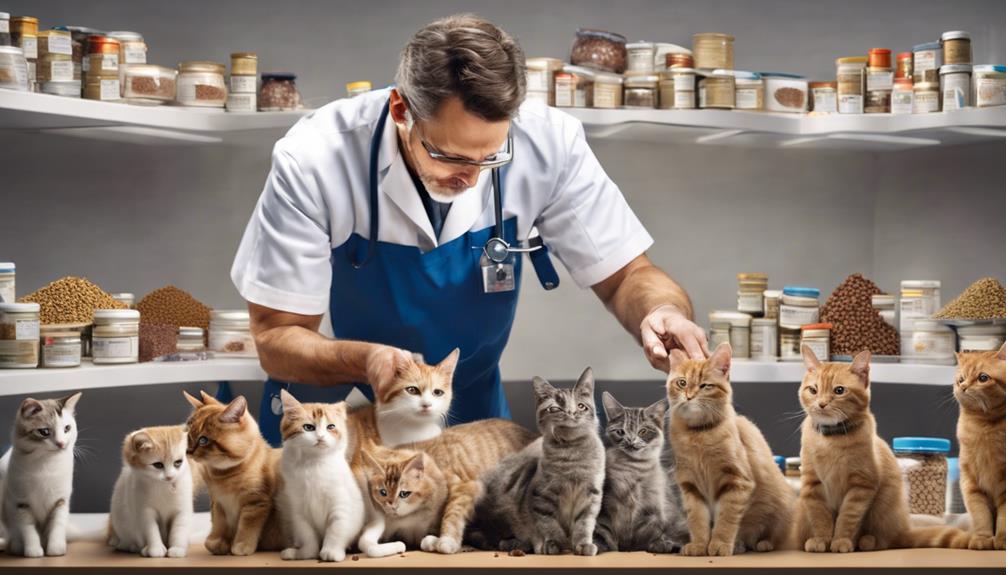
Seeking guidance from a veterinarian is crucial before shifting your cat to a raw food diet to guarantee it meets their specific nutritional needs. When contemplating a raw food diet for your feline companion, a vet consultation can provide invaluable insights. Here's why vet consultation is essential:
- Tailored Recommendations: Vets can recommend appropriate commercial raw food options that align with your cat's health and dietary requirements.
- Preventing Health Risks: Discussing the raw food diet with a vet helps in avoiding deficiencies and potential health risks associated with homemade recipes.
- Ongoing Monitoring: Regular communication with a vet allows for monitoring your cat's health condition and making necessary adjustments to the diet.
- Balancing Risks and Benefits: Vets play a crucial role in evaluating and balancing the risks and benefits of a raw food diet for your cat's overall well-being.
Consulting with a vet ensures a smooth shift to a raw diet while prioritizing your cat's health and nutritional needs.
Safety Precautions for Raw Feeding
When it comes to raw feeding for cats, safety precautions are paramount. Handling raw meat and ensuring food storage safety are essential steps in minimizing health risks.
Proper hygiene practices can help protect both your feline friend and yourself from potential bacterial contamination and parasites.
Handling Raw Meat
Managing raw meat for a cat's diet demands strict adherence to safety precautions to guarantee the health and well-being of your feline companion. When handling raw meat for your cat's meals, here are some essential safety tips to keep in mind:
- Wash hands thoroughly: Before and after dealing with raw meat, make sure you wash your hands properly to prevent the spread of harmful bacteria.
- Use separate utensils: To avoid cross-contamination, always utilize separate cutting boards and utensils for raw meat.
- Refrigerate properly: Store raw meat at the correct temperature in the refrigerator to inhibit bacterial growth.
- Thaw safely: Thaw raw meat in the refrigerator or using safe methods like cold water baths to prevent the proliferation of harmful bacteria.
Food Storage Safety
For safe raw feeding, proper food storage is essential to maintain freshness and prevent bacterial contamination. Raw cat food should always be stored in the refrigerator at temperatures below 40°F to prevent bacterial growth.
It's important to use airtight containers or packaging to store raw cat food safely and avoid cross-contamination with other foods. When thawing raw cat food, do so in the refrigerator or under cold water to uphold food safety and integrity.
Remember to discard any uneaten raw cat food after 2-3 days to steer clear of spoilage and bacterial contamination. Additionally, make sure to wash all surfaces, utensils, and hands thoroughly after handling raw cat food to prevent the spread of harmful bacteria.
Following these food storage safety guidelines is key to ensuring the health and well-being of your feline friend.
Transitioning Tips for Cats

When introducing your cat to a raw food diet, remember to take it slow and steady.
Start by offering small amounts of raw food as treats to get them accustomed to the new textures.
Consider mixing different types of meat to add variety and keep your cat interested in their new diet.
Slow and Gradual Transition
Easing your cat into a raw food diet by gradually incorporating small amounts as treats can help their system adjust smoothly. Here are some tips for a successful adaptation:
- Start Slow: Introduce raw food gradually to avoid digestive upsets.
- Use Probiotics: Enhance your cat's gut health to aid in accepting raw food.
- Consider Supplementation: High-quality meats may need additional nutrients for a balanced diet.
- Adjust as Needed: Be flexible with recipes and feeding guidelines to ease the adaptation process.
Offer Variety of Textures
To smoothly introduce your cat to a raw food diet, consider offering a variety of textures in their meals. Cats, like us, have preferences, and providing a range of textures such as nuggets, patties, or morsels can make the adjustment process easier. The diverse textures not only cater to individual tastes but also enhance the overall feeding experience.
By incorporating different textures into their meals, you can make raw cat food more appealing and increase your cat's acceptance of this new diet. Acclimating cats to raw food with a variety of textures can transform mealtime into an engaging and enjoyable experience for your feline friend.
Benefits of Raw Feeding

Feeding cats a raw diet offers numerous benefits that can enhance their overall health and well-being. Here are some key advantages of raw feeding for your feline friend:
- Improved Health: Raw feeding can lead to better digestion, oral health, coat condition, energy levels, and overall vitality in cats.
- Essential Nutrients: A complete raw diet should include essential nutrients such as animal protein, fat, taurine, and vital vitamins and minerals important for your cat's well-being.
- Adjusting to Raw Feeding: Adjusting your cat to a raw food diet may require patience and specific strategies like fasting, digestive aids, separate feeding of raw and cooked foods, and consistent portion control.
- Overall Well-being: By providing a balanced raw diet, you can make sure that your cat receives the necessary nutrients for excellent health, which can contribute to their overall well-being and longevity.
Making the switch to raw feeding can greatly benefit your cat's health and happiness, but it's crucial to do so carefully and with attention to their specific needs.
Choosing the Right Raw Cat Food
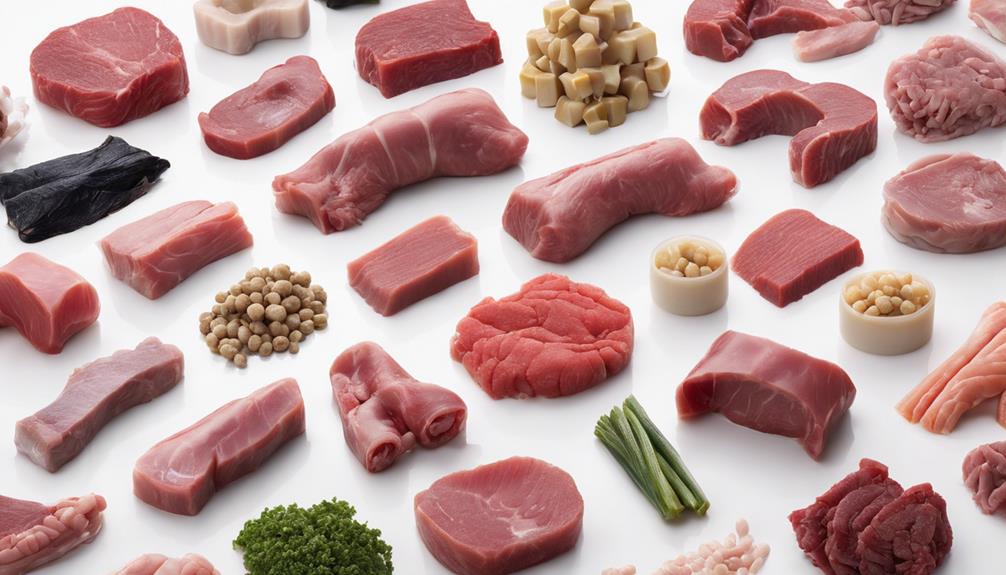
When choosing raw cat food, it's important to compare the nutritional content, making sure your feline companion receives a well-rounded diet.
Pay close attention to the quality of ingredients in the raw food to ensure your cat's health and vitality.
Follow feeding guidelines and suggestions to make the shift to raw feeding smooth and successful for both you and your cat.
Nutritional Content Comparison
Comparing the nutritional content of raw cat foods is essential for selecting the best option to meet your feline companion's dietary needs. When evaluating raw cat food options, consider the following:
- Protein Sources: Opt for raw cat foods that offer a variety of protein sources to make sure your cat receives a diverse range of nutrients essential for their well-being.
- Balanced Diet: Look for raw cat food with a balanced ratio of animal fats and oils to support your cat's energy levels and overall health.
- Essential Vitamins and Minerals: Ensure the raw cat food includes essential vitamins and minerals to meet your cat's nutritional requirements for best health.
- Taurine: Check for the presence of taurine, a critical nutrient in raw cat food that's necessary for maintaining heart health and proper function.
Quality of Ingredients
In selecting the right raw cat food, prioritize high-quality meats and organs, preferably organic or grass-fed, to guarantee top-notch ingredients for your feline companion. Making sure a balanced and high-protein diet is vital for your cat's health. Look for raw food brands that offer a variety of proteins to meet your cat's nutritional needs effectively. Check for essential nutrients like taurine, vitamins, and minerals to support overall well-being. Opt for raw cat food with a balance of animal fat and oils to boost energy levels. Including fruits and vegetables in the raw food can provide additional nutrients and fiber for ideal digestion. Here's a helpful table to guide your selection:
| Quality of Ingredients | |
|---|---|
| High-quality meats and organs | Preferably organic or grass-fed |
| Variety of proteins | Ensures a balanced diet |
| Essential nutrients | Contains taurine, vitamins, and minerals |
| Balance of fat and oils | Supports energy levels and health |
Feeding Guidelines and Tips
To guarantee excellent nutrition for your feline friend, prioritize choosing a raw cat food that provides a varied range of protein sources. When considering raw feeding for your cat, here are some essential feeding guidelines and tips for cat owners to make sure they meet their cat's nutritional requirements:
- Diverse Protein Sources: Opt for raw cat food that offers a mix of proteins like chicken, beef, and fish to provide a well-rounded diet.
- Added Fiber: Look for raw food options with added fiber to support your cat's digestion and overall gut health.
- Easy Portioning: Choose raw food formats like nuggets or patties for convenient portioning and feeding.
- Consider Preferences: Factor in your cat's dietary preferences and your convenience when selecting a raw food brand.
Best Raw Cat Foods Recommendations
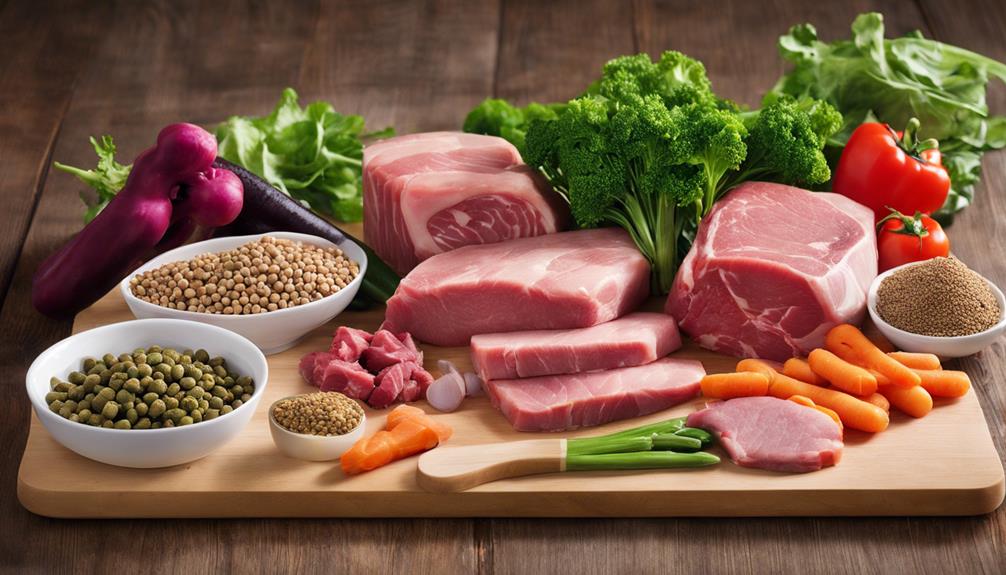
When selecting the best raw cat foods for your feline companion, consider options like Instinct Raw Boost Healthy Weight Grain Free Recipe with Real Chicken Natural Dry Cat Food. This choice is excellent for weight management, ensuring your cat stays healthy and fit.
Another top recommendation is Stella & Chewy's Raw Coated Kibble Cat Food, providing a biologically appropriate raw diet with premium ingredients that cater to your cat's nutritional needs.
For those looking for a holistic approach to feline nutrition, Primal Freeze Dried Cat Food Nuggets Venison is a fantastic option, offering high-quality protein sources for your cat's overall well-being.
If digestive health is a concern, Instinct Freeze Dried Raw Boost Mixers Grain Free Digestive Health Recipe is specifically designed to support this aspect in cats.
Ultimately, Honest Kitchen – Mmmixers Proper Toppers uses 100% human-grade ingredients to enhance the raw nutrition in your cat's diet, ensuring they receive the best possible care.
Transitioning to Raw Food Diet

Gradually introducing raw food as treats before fully shifting can help prevent digestive upsets in cats. As I shifted my feline friend to a raw food diet, I found these steps to be essential:
- Using Digestive Aids: Incorporating digestive aids like probiotics or pumpkin during the adjustment phase can support your cat's digestive system, easing the shift to raw food.
- Separating Raw and Cooked Foods: Feeding raw and cooked foods separately can help your cat adapt more easily to the new diet, making the change smoother.
- Consistent Feeding Portions and Schedules: Maintaining consistency in feeding portions and schedules is vital. It helps your cat adapt to the raw food diet by establishing routine and expectations.
- Monitoring Closely: Keep a close eye on your cat for any signs of digestive issues or nutrient deficiencies during the adjustment period. Being vigilant allows you to address any concerns promptly.
Raw Feeding Tips for Cats

As I introduced my cat to a raw food diet, I found that implementing specific feeding tips greatly aided in the adjustment.
Fasting my cat for 10-12 hours before the shift helped reduce digestive upsets during the change. Adding digestive aids like pumpkin or probiotics supported my cat's digestion as they adapted to the new diet. Separating raw and cooked foods during feeding time also proved helpful in preventing potential nutrient imbalances and aiding in digestion.
Consistency in feeding portions and schedules played a significant role in helping my cat adapt to the raw food diet more easily. By maintaining a regular feeding routine, my cat slowly but steadily adjusted to the new diet.
It's important to monitor your cat closely for any signs of digestive issues or nutrient deficiencies during this shift period. Being observant and responsive to your cat's needs is essential for a successful switch to a raw food diet.
Feeding Guidelines for Raw Diets
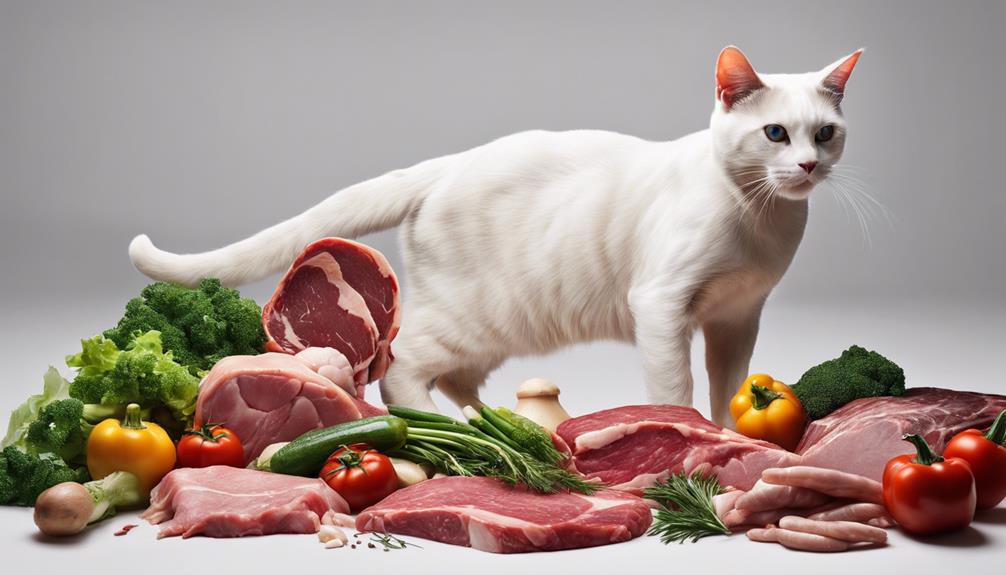
Implementing proper feeding guidelines is crucial for successfully converting your cat to a raw diet. When shifting your cat to a raw diet, consider the following tips:
- Gradual Change: Start by offering small amounts of raw food as treats to accustom your cat to the new diet slowly.
- Probiotics for Digestive Support: Consider incorporating probiotics to help maintain a healthy digestive system during the change to raw diets.
- Supplementation for Balance: Some high-quality meats may require additional supplementation to guarantee your cat receives a well-balanced raw diet.
- Adjustments for Success: Even when following feeding guidelines and recipes, be prepared to make adjustments to the diet as needed for a smooth change.
Frequently Asked Questions
What Is the Best Raw Food Brand for Cats?
I think the best raw food brand for cats is Stella & Chewy's. Their freeze-dried options are excellent, and my feline friend absolutely loves them. The quality and variety make it a favorite in our household.
Do Vets Recommend a Raw Diet for Cats?
I think some veterinarians suggest raw diets for cats depending on individual requirements and health factors. Seeking advice from a vet is essential to make sure the diet is nutritionally balanced and safe. Switching to raw food should be closely monitored.
Is Raw Food Actually Better for Cats?
Certainly, raw food is superior for cats. Research suggests that raw diets enhance cats' digestion, coat health, and vitality. Personally, I've witnessed my cat flourish on raw food, displaying heightened energy and a glossier coat.
Do Cats Need Supplements on Raw Diet?
I believe cats may need supplements on a raw diet. Taurine, omega-3s, and vitamin E are essential for their health. Consulting a vet for personalized advice is wise. It's ultimately about ensuring your feline friend gets all the nutrients they need.
What Raw Food Diet is Best for Maintaining My Cat’s Health and Size?
When considering a raw food diet for your cat, it’s essential to learn about cat heights. This will help you determine the best diet to maintain their health and size. Consult with a veterinarian or pet nutritionist to ensure your cat is getting the right nutrients from their raw food diet.
Conclusion
To sum up, shifting your cat to a raw food diet can be like introducing them to a gourmet meal after a lifetime of fast food. With the right guidance and precautions, your feline friend can enjoy the benefits of a natural and nutritious diet.
Remember to consult with your veterinarian, follow feeding guidelines, and monitor your cat's health closely. By making informed choices, you can provide your cat with the best raw food for a healthier and happier life.

